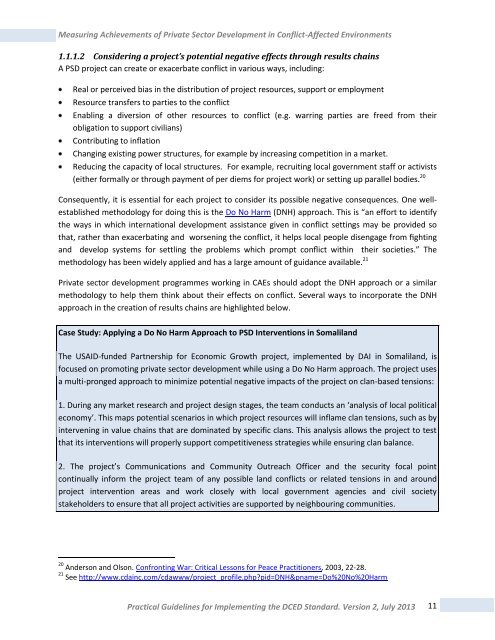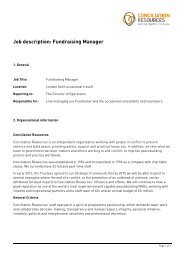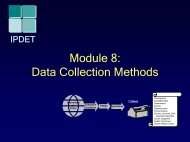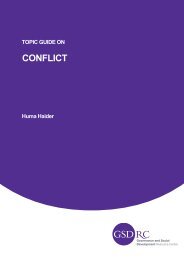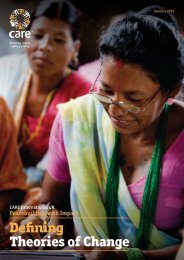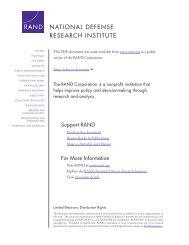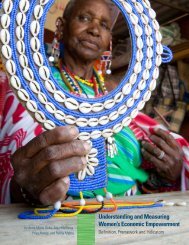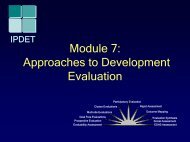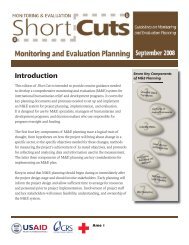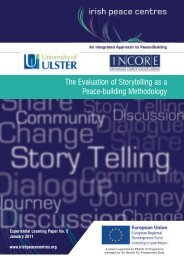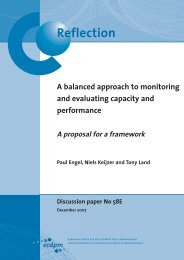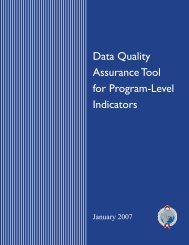Measuring Achievements of Private Sector Development in ... - DCED
Measuring Achievements of Private Sector Development in ... - DCED
Measuring Achievements of Private Sector Development in ... - DCED
Create successful ePaper yourself
Turn your PDF publications into a flip-book with our unique Google optimized e-Paper software.
<strong>Measur<strong>in</strong>g</strong> <strong>Achievements</strong> <strong>of</strong> <strong>Private</strong> <strong>Sector</strong> <strong>Development</strong> <strong>in</strong> Conflict-Affected Environments<br />
1.1.1.2 Consider<strong>in</strong>g a project’s potential negative effects through results cha<strong>in</strong>s<br />
A PSD project can create or exacerbate conflict <strong>in</strong> various ways, <strong>in</strong>clud<strong>in</strong>g:<br />
Real or perceived bias <strong>in</strong> the distribution <strong>of</strong> project resources, support or employment<br />
Resource transfers to parties to the conflict<br />
Enabl<strong>in</strong>g a diversion <strong>of</strong> other resources to conflict (e.g. warr<strong>in</strong>g parties are freed from their<br />
obligation to support civilians)<br />
Contribut<strong>in</strong>g to <strong>in</strong>flation<br />
Chang<strong>in</strong>g exist<strong>in</strong>g power structures, for example by <strong>in</strong>creas<strong>in</strong>g competition <strong>in</strong> a market.<br />
Reduc<strong>in</strong>g the capacity <strong>of</strong> local structures. For example, recruit<strong>in</strong>g local government staff or activists<br />
(either formally or through payment <strong>of</strong> per diems for project work) or sett<strong>in</strong>g up parallel bodies. 20<br />
Consequently, it is essential for each project to consider its possible negative consequences. One wellestablished<br />
methodology for do<strong>in</strong>g this is the Do No Harm (DNH) approach. This is “an effort to identify<br />
the ways <strong>in</strong> which <strong>in</strong>ternational development assistance given <strong>in</strong> conflict sett<strong>in</strong>gs may be provided so<br />
that, rather than exacerbat<strong>in</strong>g and worsen<strong>in</strong>g the conflict, it helps local people disengage from fight<strong>in</strong>g<br />
and develop systems for settl<strong>in</strong>g the problems which prompt conflict with<strong>in</strong> their societies.” The<br />
methodology has been widely applied and has a large amount <strong>of</strong> guidance available. 21<br />
<strong>Private</strong> sector development programmes work<strong>in</strong>g <strong>in</strong> CAEs should adopt the DNH approach or a similar<br />
methodology to help them th<strong>in</strong>k about their effects on conflict. Several ways to <strong>in</strong>corporate the DNH<br />
approach <strong>in</strong> the creation <strong>of</strong> results cha<strong>in</strong>s are highlighted below.<br />
Case Study: Apply<strong>in</strong>g a Do No Harm Approach to PSD Interventions <strong>in</strong> Somaliland<br />
The USAID-funded Partnership for Economic Growth project, implemented by DAI <strong>in</strong> Somaliland, is<br />
focused on promot<strong>in</strong>g private sector development while us<strong>in</strong>g a Do No Harm approach. The project uses<br />
a multi-pronged approach to m<strong>in</strong>imize potential negative impacts <strong>of</strong> the project on clan-based tensions:<br />
1. Dur<strong>in</strong>g any market research and project design stages, the team conducts an ‘analysis <strong>of</strong> local political<br />
economy’. This maps potential scenarios <strong>in</strong> which project resources will <strong>in</strong>flame clan tensions, such as by<br />
<strong>in</strong>terven<strong>in</strong>g <strong>in</strong> value cha<strong>in</strong>s that are dom<strong>in</strong>ated by specific clans. This analysis allows the project to test<br />
that its <strong>in</strong>terventions will properly support competitiveness strategies while ensur<strong>in</strong>g clan balance.<br />
2. The project’s Communications and Community Outreach Officer and the security focal po<strong>in</strong>t<br />
cont<strong>in</strong>ually <strong>in</strong>form the project team <strong>of</strong> any possible land conflicts or related tensions <strong>in</strong> and around<br />
project <strong>in</strong>tervention areas and work closely with local government agencies and civil society<br />
stakeholders to ensure that all project activities are supported by neighbour<strong>in</strong>g communities.<br />
20 Anderson and Olson. Confront<strong>in</strong>g War: Critical Lessons for Peace Practitioners, 2003, 22-28.<br />
21 See http://www.cda<strong>in</strong>c.com/cdawww/project_pr<strong>of</strong>ile.phppid=DNH&pname=Do%20No%20Harm<br />
Practical Guidel<strong>in</strong>es for Implement<strong>in</strong>g the <strong>DCED</strong> Standard. Version 2, July 2013<br />
11


